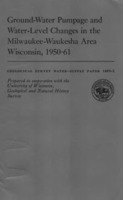Ground-water pumpage and water-level changes in the Milwaukee-Waukesha area, Wisconsin, 1950-61
Links
- Document: Report (pdf)
- Plates:
- NGMDB Index Page: National Geologic Map Database Index Page (html)
- Download citation as: RIS | Dublin Core
Abstract
Artesian water pressure in the deep sandstone aquifer continued to decline throughout most of the Milwaukee-Waukesha area, Wisconsin between 1950 and 1961. Areas of greatest water-level decline were in northeast Waukesha County and in northwest Milwaukee County. The chief cause of the decline was continued heavy pumpage. The major aquifers of southeastern Wisconsin are the Niagara aquifer, which is primarily Niagara Dolomite of Silurian age, and the sandstone aquifer, which consists of sandstones of Cambrian and Ordovician ages. Locally, the glacial sands and gravels ,of Pleistocene age also are important aquifers. In the Milwaukee-Waukesha area, the sandstone aquifer is completely artesian, confined above by the Maquoketa Shale. The Niagara aquifer is generally unconfined. Pumpage from the sandstone aquifer in the Milwaukee-Waukesha area de- creased from about 23.3 million gallons per day in 1950 to about 20.9 million gallons per day in 1961. The principal reason for decreased pumpage was sub- stitution of surface-water supply from Lake Michigan. Between 1950 and 1961, the water-level changes in wells in the sandstone aquifer ranged from plus 10 feet at Town of Lake to minus 98 feet in northwest Milwaukee. Except for a small area near Town of Lake, water levels in wells in the Milwaukee-Waukesha area were lower in 1961 than in 1950. Water-level changes were directly related to the pumpage pattern and pump- age changes. Increased pumpage at Waukesha and in northwest Milwaukee and continued heavy pumpage at Wauwatosa caused widespread water-level declines in northeast Waukesha County and in northwest Milwaukee County. Locally, decreased pumpage at West Milwaukee allowed limited recovery of water levels since 1957. Estimates of pumpage through the year 1975 indicate a pumpage decrease in the middle 1960's, followed by an increase in the late 1960's and early 1970's. Additional conversion to surface-water supply in Milwaukee County will account for most pumpage decreases. Increased pumpage is most likely in Waukesha County where the population is expanding rapidly and an adequate surface-water supply is not readily accessible. The westward shift of the pumpage pattern may cause an additional water-level decline of about 50 feet at Waukesha but will permit water levels to recover about 100 feet at West Allis by 1975. Partial or complete conversion to surface-water supplies by municipalities that depend entirely on water from the sandstone aquifer would allow greater use of the sandstone aquifer by isolated suburban developments and industries.
Study Area
| Publication type | Report |
|---|---|
| Publication Subtype | USGS Numbered Series |
| Title | Ground-water pumpage and water-level changes in the Milwaukee-Waukesha area, Wisconsin, 1950-61 |
| Series title | Water Supply Paper |
| Series number | 1809 |
| Chapter | I |
| DOI | 10.3133/wsp1809I |
| Year Published | 1965 |
| Language | English |
| Publisher | U.S. Geological Survey |
| Contributing office(s) | Wisconsin Water Science Center |
| Description | Report: iii, 19 p. ; 2 Plates: 19.50 x 24.00 inches and 18.50 x 24.00 inches |
| Larger Work Type | Report |
| Larger Work Subtype | USGS Numbered Series |
| Larger Work Title | Contributions to the hydrology of the United States |
| Country | United States |
| State | Wisconsin |
| City | Milwaukee, Waukesha |
| Online Only (Y/N) | N |
| Additional Online Files (Y/N) | Y |


